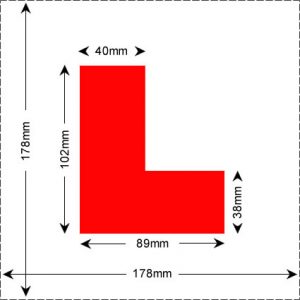Motorcycle L Plate Law Explained
Putting L plates on a moped or motorcycle does nothing to improve the looks of your machine. In fact, many learner riders often try to cut L plates down in size or attempt to hide them using various creative techniques.

Until you pass the motorcycle or moped test, the law requires that you must display an L plate on the front and back of your vehicle. That is unless your passed your car test before 1 February 2001, in which case you can ride a moped up to 50 cc without L plates.
Motorcycle L Plate Size
Full regulation size L plates must be displayed on the front and rear or your motorcycle or moped. The L plate diagram illustrates the correct size that must be displayed.
Cutting L Plates
Some learner riders cut L plates in order to reduce the total size of the plate. This is illegal and may result in a fine and up to 6 penalty points.
You are legally permitted to trim the corners of your L plates, but reducing the overall size of the L plate from its 178 mm (7 inch) square would be an offence.
Displaying L Plates
As a learner rider, you have little road experience and as such, L plates are used to inform other road users. L plates must be fixed in an upright position to that they are clearly visible from the front and back. For an example of where you should place L plates, see:
Sticking L Plates to Mudguards
Sticking L plates to mudguards may be a quick and easy solution, but if the L plate is not in an upright 90 degree angle to the road, it’s likely an offence. How hard police officers come down on this varies, but it may result in penalty points and a fine.
